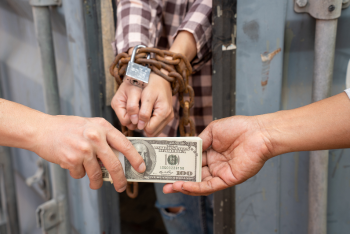by Mary Adams, AWC The Hague and Human Rights Co-chair
This article examines the intersection of human trafficking with climate change, conflict, COVID-19 and technology. Challenges often bring opportunities, so we will conclude with positive impacts.
Climate change
 In 2021, climate-related disasters led to the displacement of nearly 24 million people globally. The adverse impacts of climate change magnify other drivers of displacement, such as loss of livelihoods, poverty, food insecurity, and a lack of access to water and other resources, pushing people to migrate and exposing these vulnerable populations to human trafficking now more than at any other point in the past five decades.1
In 2021, climate-related disasters led to the displacement of nearly 24 million people globally. The adverse impacts of climate change magnify other drivers of displacement, such as loss of livelihoods, poverty, food insecurity, and a lack of access to water and other resources, pushing people to migrate and exposing these vulnerable populations to human trafficking now more than at any other point in the past five decades.1
Conflict
Human trafficking is an increasingly common feature of modern conflict, whether national or international. Ghada Waly, Executive Director of the United Nations Office on Drugs and Crime (UNODC) commented, “Human traffickers prey on the desperation of people affected by conflict and humanitarian crises in countries of origin, transit and destination. We need strong action to reduce vulnerability to human trafficking, also in times of crisis, and close cooperation if we are to effectively prevent and combat the crime.”2
COVID-19
The UNODC report on “The Effects of the COVID-19 Pandemic on Trafficking in Persons”3 provides a series of recommendations based on the lessons learned shared by experts for strengthening the anti-trafficking response during crises. Their final remark: “The coming years will show if we will be able to strengthen sustainable responses to trafficking in persons, learning from each other, and recognizing new trends in trafficking in persons cases, identifying victims and their needs for assistance in a victim-centered, age- and gender-sensitive as well as trauma-informed way.”4
Trafficking is profitable in a digital age
With 4.2 billion people already having access to the internet in 2018, information and communications technology continues to play an important role in the field of trafficking in human beings. Technology has broadened criminals’ ability to traffic human beings for different types of exploitation (including sexual and labor exploitation, the removal of organs, illegal adoption of children and forced marriages).5
Positive impacts
Global trends in national infrastructure for reporting, the rise of anti-trafficking technology, and social media are having a positive impact on raising awareness and combatting human trafficking.
The role of the National Rapporteur
EU Member States have an obligation to establish national rapporteurs or equivalent mechanisms.6 Their responsibilities include assessments of trends in trafficking in human beings, measuring results of anti-trafficking actions, gathering statistics, and national reporting. In 2021, National Anti-Trafficking Co-ordinators and Rapporteurs from 60 countries met in Strasbourg and online for the largest annual meeting of its kind focused on human trafficking.
Technology is an anti-trafficking toolset
Despite its frequent misuse, technology can be an important asset for those involved in combating trafficking in persons. In June 2018, a coalition of global tech companies, civil society organizations and international institutions jointly launched Tech Against Trafficking,7 a collaborative effort to support the eradication of human trafficking.8 Private sector efforts such as this enable countries to innovate their national action plans using big data analysis, cybersecurity, blockchain technology, and artificial intelligence.
Technology can expand human trafficking resources
Human trafficking is happening in plain sight all around us. Many organizations are developing mobile apps for the general public and workers to report suspicious activity. Have you ever seen something that looks out of place? As a global citizen, if we spot something that doesn’t look right, we can now use mobile apps to report it. The “FREEDOM!” app9 is a globally available human trafficking mobile application that empowers individuals to report cases of human trafficking anonymously and safely in 10 languages at three levels: victim, trafficker, suspicious activity.
Footnotes:
1 Global Slavery Index | Walk Free
4 Ibid.
5 The challenges of countering human trafficking in the digital era | Europol
6 EU Anti-Trafficking Directive
Image courtesy of Canva.com

